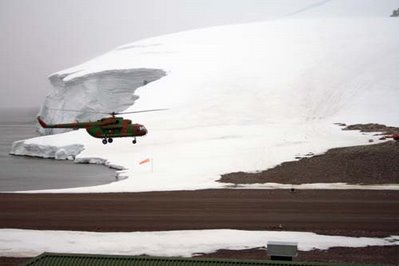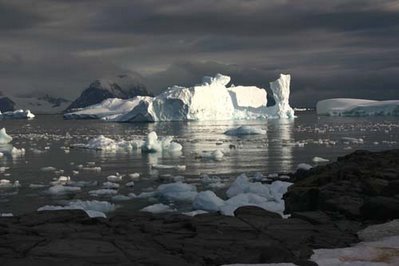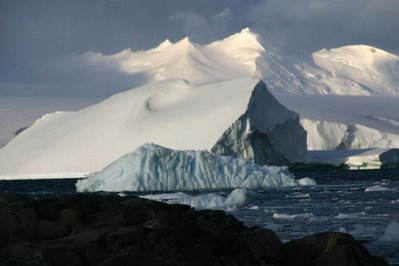
Russian helicopter landing


In many ways the experience of Antarctica has been a big surprise. I expected to be out in the landscape most of the time. But in truth Antarctica is a dangerous and unpredictable place and I am here as part of a large organisation who have to ensure everyone’s safety. So there are few designated areas you can walk or ski to alone. If you go further afield you need to go with a field assistant, and understandably most of those are out in deep field with science projects, and any remaining have been training all of the many summer personnel who arrived with me.
The dangers were highlighted just recently when two Russian helicopters, on their way South and due to refuel here, got lost in low cloud and bad visibility. Unable to fly at the required 11,000 ft to clear these local mountains because of icing on their rotors, they could easily have crashed, Fortunately some skilled sheparding in the ops tower, brought them in safely.
So for these first 3 weeks the experience has been primarily a social one. There are a hundred or more people here from all walks of life. It’s a bit like being in Noah’s Ark without the animals, but two of every one else: plumbers, carpenters, electricians, doctors, mechanics, engineers, met officers, pilots, air traffic controllers, artists, divers, boat people, chefs, cleaners, IT people, Field and base GA’s, Base commander and subordinates etc etc, along with the two ships and their crew, plus a team of subcontracted builders constructing the new base building. All of this ensuring a political presence in Antarctica headed by its world-leading science program, which takes all of this infrastructure to put them into the field and costs many millions of pounds.
The resulting experience is one of social interaction, particularly over Christmas and New Year, mostly confined to the interior of an overheated base building. This in itself is an interesting experience, like society in miniature, held by a thread from going feral by daily news précis, and weekend print outs of the Guardian and Observer.
In the labs and on the ships, scientists are measuring sea temperature and salinity and studying the marine life here and how it adapts to its environment and what changes in sea temperature will mean for these creatures.
Geologists are hunting for fossils in the Nunatacs which protrude from the ice cap to understand what went on here before it was covered in ice. Other scientists are looking at air temperatures, ozone depletion etc, and glaciologists are looking at glacier flow to determine the history of rates of flow, fluctuations and what it will mean if the whole system is speeding up with sea ice break ups.
There is a program running from aircraft flight lines, which bounces echoes off the ice cap and gives a visual picture of the thickness of the ice, the pattern of the underlying bed rock, with melt lakes etc, plus various historical events such as eruptions or large meteorite strikes and in so doing, maps the history of the earth over the last 900,000 years. A kind of echoearthgram. All of this is truly fascinating and provides me with a great deal to think about as well as interesting visual material with which to work on my return.
In the here and now met officers can give me detailed satellite pictures of cloud and weather formation, wind and pressure maps etc. On the ships there is a software that gives echo pictures, through the cloud base of sea ice formation. Incredibly accurate as well as providing me with new visual forms of water flow. All of this information I am collecting on a regular basis.
Man cannot live here without bringing all his needs for survival with him. For BAS science this means a vast infrastructure which is being powered by oil, the overuse of which in the western industrialised world is one of the main causes of the climate change, being studied here. I am part of this, and the realisation of that is one of the primary experiences of being here. The science is really interesting.
The land itself and the experience of it is absolute. It is so stunningly beautiful, that in the face of it art has no place. As a result I am increasingly reluctant to do anything much in it, apart from make marks with my feet or a skidoo in the snow. I have no wish to use other resources to make a futile impression on what is absolute. I will be content to record on film and photograph what is here and to let the experience of place; land, weather, people and science, become embed deep within me.
Within the next day or so I shall be going deep into the field, to Sky Blu on the ice cap. Accommodation at this remote depot is a tent or fibreglass dome with a handful of people. This will no doubt be a more raw experience of the landscape than Rothera Base, but even so, being supported by that infrastructure, it will still remain a part of it. I have plans to make a drawing of a wind vortex; pre programmed into a GPS and to be drawn in new snow (if we get any) with a skidoo, then filmed being blown away with the wind.
7 comments:
Hello Chris
Thank you for sharing this experience. It is such an wonderful insight into a unique land/icescape, so far removed from my mild, damp, winter darkness of Norfolk. I am so pleased I found your blog. I was looking up info on environmental art in UK and there you were,an artist who's work I admire, sharing a very special exploration,its very exciting to feel a kind of real time involvement. Thank you Sue
Dear Chris-
Getting caught up on your activities in Antarctica.I do miss having you around here!
I may have missed something, but could you post a map in the blog's directory of where you are? We'd love to look it up on our atlas at home.
All the best,
Joseph
Hi Chris
It all sounds amazing and so far from everyday life. It is grey and damp here and not at all crisp and cold- your environment sounds far more satisfying- if terrible (in the real sense of awe-inspiring). We miss you here but are really looking forward to having you back and hearing about everything, if you can process so much. My friend has been on that trip as an oceanographer and I realise that I have not asked her enough about it and curiously somehow she has not spoken much about it. I'll let her have the details of your blog.
Take care and enjoy it.
Nannette
Hi Chris
Yes antartica is beautiful but please get busy with your work so you can high light what we might be losing if we don't do something about climate change
22/1/07. Have been following your blog with interest as I have (almost accidentally) followed the work of other artists Simon Faithfull, Layla Curtis and John Kelly who have also travelled to the Antarctic with BAS. Looking forward to your next blog entry.
Saw something on the news the other day about a British team who have reached the Pole Of Innaccessibility and it made me wonder where you are and what you are doing.
Hope that you will be giving talks about your experience on your return and look forward to seeing the work which evolves.
It is a fascinating, beautifully written and illustrated story. Little details, like the fact that it takes 7 barrels of oil to bring in 1, make it so much more alive. Such beauty! I look forward to the ensuing work.
love, Pat
Dear Ms Drury: I very much enjoyed viewing your Antartica pictures and commentary. I'm curious as to the naming of Lanzarotti Nunatak. As you see my sur name is Lanzarotti and my curiosity is aroused. I can't seem to find anything on the net as to its naming. Thanks for listening. GJ Lanzarotti
Post a Comment